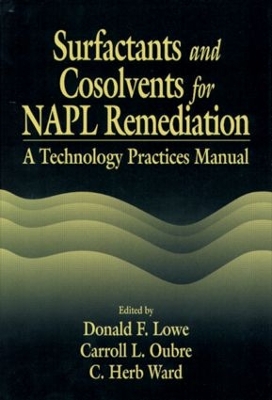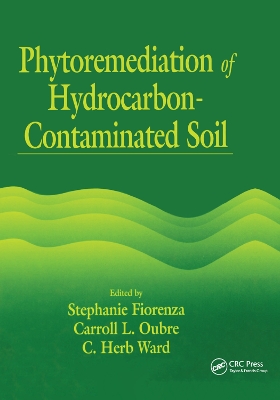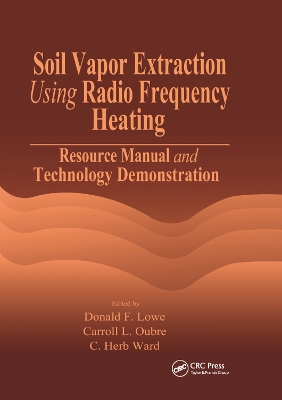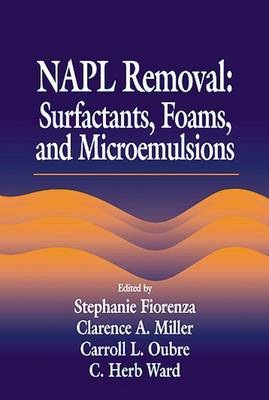AATDF Monograph
5 primary works • 7 total works
Book 1
Surfactants and Cosolvents for NAPL Remediation A Technology Practices Manual
by Donald F. Lowe, Carroll L. Oubre, and C H Ward
A $19.3 million Department of Defense grant to Rice University funds the Advanced Applied Technology Demonstration Facility (AATDF). One of the project goals is the development of reduction strategies for nonaqueous phase liquids (NAPLs) in the subsurface. Surfactants and Cosolvents for NAPL Remediation records the results of AATDF research.
The manual is a guide to the practical application of surfactants/cosolvent for in situ remediation. It is targeted to decision makers and anyone concerned with the design or implementation of these technologies.
The book discusses the situational viability of surfactants/cosolvents , the possible results, design, and operation. It includes case studies, step-by-step guidance, and project cost work sheets.
The successful results of the AATDF research, as documented Surfactants and Cosolvents for NAPL Remediation, are an invaluable contribution to the future of subsurface remediation. Without source NAPL reduction, the alternative is decades of plume management through pump-and-treat.
Book 2
Phytoremediation of Hydrocarbon-Contaminated Soils
by Stephanie Fiorenza, Carroll L. Oubre, and C H Ward
Interest in phytoremediation as a solution for contaminants in groundwater and soil has exploded. The project documented in Phytoremediation of Hydrocarbon Contaminated Soils presents innovative technology for environmental clean up using in situ treatment. It describes the results of a field study focusing on hydrocarbon contamination, especially polynuclear aromatic hydrocarbons, in surface and near surface soils.
The field demonstration used soils contaminated with aged diesel fuels. The random block design enabled the investigators to test the statistical difference in the effects of different vegetated and unvegetated treatments. They tested the degradation of diesel and polynuclear aromatic hydrocarbon components in plots containing three different vegetation treatments, two grasses and a legume, and a non-vegetated control.
Part one of the monograph gives a complete and thorough account of the results of the field study. Part two covers the design and potential costs of a full-scale implementation of the demonstration system as well as the performance and potential application of the new technology.
Phytoremediation of Hydrocarbon Contaminated Soils supplies quantitative results about the use of vegetation in soil remediation. The information given on the niches and limitations of the technologies allows for a more informed selection of remedial solutions for environmental cleanup.
Book 3
Modular Remediation Testing Systems
by C H Ward, Carroll L. Oubre, and Katherine Balshaw-Biddle
Modular Remediation Testing Systems documents a unique modular testing environment designed for use in the development of remediation technology and for on-site selection of remedial technologies. This complete design and operation manual gives you the tools you need to conduct successful, cost effective remediation projects. The major attributes of this system, the Experimental Controlled Release System (ECRS), that distinguish it from past test facilities include the following:
This monograph presents key information needed to design, construct, and operate similar modular remediation testing systems or to utilize the two existing modular ECRS facilities. The well-sealed, above-ground modular system design minimizes leaks to the environment, facilitates mass balances, and controls test conditions. This allows for multiple uses with minimal permitting.
Modular Remediation Testing Systems is a comprehensive reference for researchers in environmental engineering and for engineering consultants and regulators looking for a pilot-scale system. These pilot-scale systems are uniquely suited to both research development and real-world application at remediation sites.
Book 4
Subsurface Contamination Monitoring Using Laser Fluorescence
by Katharine Balshaw-Biddle, Carroll L. Oubre, and C H Ward
While innovative technologies in remediation need to be developed, so do innovative ways of site assessment. This monograph describes the development, testing, and performance of a new laser-induced fluorescence soil probe. A screening tool for site characterization, this probe has the potential to provide an economical, rapid assessment of contaminated sites.
Cone Penetrometer testing equipment advances the probe into the subsurface. The probe identifies hydrocarbon classes using a multi-channel excitation-emission matrix. This technique facilitates the collection of significant amounts of subsurface information - surpassing conventional data collection methods - that can be used to rapidly identify areas of concern beneath a site. The technology has significant application for the following:
Subsurface Contamination Monitoring Using Laser Fluorescence provides comprehensive reference material for researchers and engineers as well as engineering consultants interested in subsurface monitoring techniques or further development of this technology. It describes innovative technology that focuses on finding cost effective solutions for site assessment and remediation.
Book 6
Soil Vapor Extraction Using Radio Frequency Heating
by Donald F. Lowe, Carroll L. Oubre, and C H Ward
One of the most widely used techniques for treating soils contaminated with volatile organic compounds, soil vapor extraction (SVE) can also be applied to semi-volatile organic compounds (SVOCs) if the soil is heated, by applying electromagnetic energy in the radio frequency (FR) range, to increase the vapor pressure of the contaminants. Although RF-SVE systems used in previous field demonstrations have had varying degrees of success, questions remain concerning its viability and cost-effectiveness.
Soil Vapor Extraction Using Radio Frequency Heating: Resource Manual and Technology Demonstration covers detailed scientific and engineering information that answers these questions. The book includes the necessary databases, equations, and example calculations for RF heating. The theoretical and practical information included will facilitate future testing of RF-SVE treatment of soils.
Additionally, the book provides information for a full-scale engineering design of potential RF-SVE applications. The authors use this information to examine predicted performance, magnitude of costs, and modifications to the design that may decrease cost. Soil Vapor Extraction Using Radio Frequency Heating: Resource Manual and Technology Demonstration gives an economic analysis of this innovative technology and considers other possible applications for it.
Features
In situ surfactant and cosolvent flushing for nonaqueous phase liquids constitutes a technique with the potential to reduce the mass of NAPL - a continuing source of groundwater contamination. This monograph details two technologies - surfactant/foam and single-phase microemulsion - selected for their potential to address the needed breakthroughs.
Copiously illustrated with figures and tables, NAPL Removal: Surfactants, Foams, and Microemulsions takes you through the entire field demonstration step-by-step. It describes the development of the processes, analyzes the costs, discusses design issues, and covers performance and potential application.
Reuse of Surfactants and Cosolvents for NAPL Remediation
by Donald F. Lowe, Carroll L. Oubre, and C H Ward
The field demonstration focused on the recovery of surfactants ready for reuse and included the following objectives:
Recovery and reuse of surfactants used in site remediation can substantially improve the overall economics. Prior to this project, it had not been demonstrated that a surfactant recovery process could be reliably designed and operated at field conditions. Nor had the question of the most cost effective surfactant recovery scheme been addressed. Reuse of Surfactants and Cosolvents for NAPL Remediation highlights innovative and cost effective technologies for ground water remediaiton.






